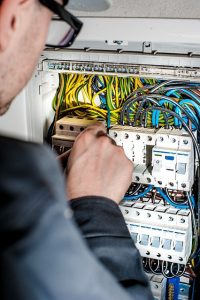Electricians lay-out, install, and test electrical service and electrical wire systems used to provide heat, light, power, air conditioning, and refrigeration in homes, office buildings, factories, hospitals, and schools. They also install conduit and other materials, and connect electrical machinery, equipment, and controls and transmission systems.

Working Conditions
Electricians work both in and outside. They work in all kinds of weather while installing grounding and temporary lights and power. The work is active and strenuous with much of it done in awkward positions and frequently in cramped quarters. They must do considerable standing, reaching, bending, stooping, climbing, carrying, and lifting in order to install electrical conduit and equipment.
Aptitude and Interest
Applicants interested in becoming electricians must enjoy working with math problems and be able to work with fine measurements. They must be able to work very carefully, without close supervision, have steady nerves, and possess a great deal of patience. Prospective electricians should have above average intelligence, the ability to visualize detailed sketches, finger dexterity, understanding of electrical theory, and be able to plan sequences of operations. Good color vision is also important.
Training
To become a skilled electrician training is essential and trade licenses are required.
It is generally accepted that the more formalized training programs give more comprehensive skill training.
Licenses: Connecticut Occupational Licensing Regulations require a minimum number of on-the-job-training years – Electrical License
Recommended high school courses include English, algebra, geometry, trigonometry, physics, mechanical drawing, blueprint reading, and general shop.
**Wage and compensation information based on CT Department of Labor data reported as of July 1, 2024.
***Apprentices are paid on a graduated scale as their skill and experience increases.
